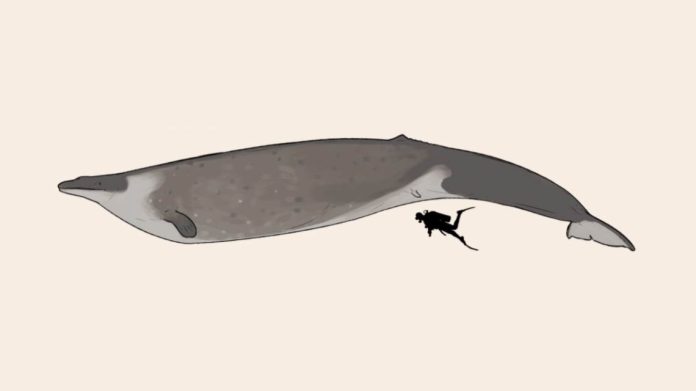It is an oft-repeated and well-known fact that blue whales are the largest animal in the world — but a recent discovery in Peru means they may possibly no longer be the heaviest.
Here’s everything you need to know about the prehistoric whopper that dwarfs modern-day cetaceans (at least in bulk).
How Big Are Blue Whales?
In the waters of the North Atlantic and North Pacific, adult blue whales can grow up to 90 feet long and weigh more than 100,000 pounds! And these aren’t even the biggest ones. Individuals in the Antarctic measure upwards of 110 feet and pack 330,000 pounds. Such massive animals also enjoy long lives, boasting lifespans of 80 to 90 years.
That said, history tells of record-breaking outliers, including one blue whale that came in at a mind-boggling 418,878 pounds. Gargantuan? Absolutely! But even this record-breaker has nothing on an ancient whale recently discovered in the Peruvian desert.
The Colossal Whale From Peru
More than a decade ago, Mario Urbina of the University of San Marcos’ Natural History Museum in Lima stumbled upon a jaw-dropping find. An animal with such behemoth bones that it took scientists years to excavate and remove them. The steep, rugged slopes of the Ica Desert did little to aid this endeavor.
Why dig in a desert for marine animal bones? Because once upon a time, the area sat submerged beneath the waves of an ancient ocean still revealing surprising marine fossils. After researchers finished their excavation, they realized they had something huge on their hands — literally.
An ancient whale from Peru, known as Perucetus colossus, could be the largest animal ever recorded, scientists say https://t.co/z61W607g1F pic.twitter.com/uL7KJkwTQM
— Reuters (@Reuters) August 3, 2023
Urbina and his team recovered 13 of the whale’s vertebrae, a hip bone, and four rib bones. The vertebrae tipped the scales at roughly 220 pounds each, and the ribs measured approximately five feet long!
Researchers waited until this year to officially release information about the new species. Christened Perucetus colossus, the scientific moniker translates as “the colossal whale from Peru.”
“Different From Anything We Know”
As for its description, Hans Thewissen of Northeast Ohio Medical University sums it up best: “It’s just exciting to see such a giant animal that’s so different from anything we know.” Alberto Collareta of Italy’s University of Pisa seconds Thewissen’s sentiments, noting, “[The bones] are unlike anything I’ve ever seen.”
Of course, these declarations beg the question. With only a handful of bones to its name, how do scientists “know” so much about the Perucetus colossus?
How Did Scientists Measure the Extinct Animal?
It took creative investigative work. For starters, they used a 3D scanner to peer beneath the surface of the bones, providing valuable insights.
Next, they relied on comparisons of modern mammal anatomy and scale ratios to estimate its ultimate weight and size. What did they discover? A mighty big critter! Their calculations pointed to an animal that weighed approximately 188,000 pounds at its low end. In other words, the smallest examples of Perucetus colossus were around the same weight as today’s blue whales.
But when it comes to the really big ones? There’s nothing comparable on the planet today. At the high end of the scale, the “colossal whale from Peru” weighed 750,000 pounds. That’s more than twice as heavy as the extra-large blue whales found in the Antarctic, or the equivalent of around 63 African elephants at 12,000 pounds apiece.
Where the Ancient Whale Falls Short
Despite its insane girth, Perucetus colossus can’t compare to blue whales in one major area: length. Unlike today’s giants, the ancient whale stretched just 66 feet, meaning blue whales are still the planet’s longest animal.
What are some other differences worth noting? P. colossus’s bones proved far denser than those of blue whales, hence the tremendous weight. This suggests the animal stayed close to the seafloor, where it scavenged for food, not unlike contemporary manatees.

Credit: SpinoDragon145 Via Wikimedia Commons (CC BY-SA 4.0).
What Did the Heaviest Animal Ever Eat?
While the bones indicate the animal stuck to shallow coastal waters, it’s hard to say exactly what it ate. Why? Because researchers have yet to uncover a skull. Although some scientists speculate it may have devoured tons of krill (like blue whales) and other miniature sea creatures, not everyone’s convinced.
Thewissen elaborates, “I wouldn’t be surprised if this thing actually fed in a totally different way that we would never imagine.” When will we find out more about this hefty manatee-style cetacean? That depends on what the fossil record divulges in the coming years.
Fortunately, you don’t have to wait to learn more about today’s marine animals. Find a Ripley’s Aquarium near you and dive into adventure.
By Engrid Barnett, contributor for Ripleys.com
EXPLORE THE ODD IN PERSON!
Visits: 0












